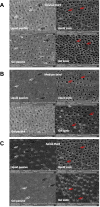The Effect of Viscosity and Application Mode of Phosphoric Acid on Bond Strength of GlassFiber Post
- PMID: 32161504
- PMCID: PMC7049749
- DOI: 10.2147/CCIDE.S230134
The Effect of Viscosity and Application Mode of Phosphoric Acid on Bond Strength of GlassFiber Post
Abstract
Background: When a phosphoric acid is used, before applying an adhesive system, it is known that obtaining an effective adhesion to the root canal walls is a challenge. The aim of the present study was to evaluate the influence of phosphoric acid viscosity and application mode on the push-out bond strength (BS) values of fiberglass post to root dentin. The conditioning pattern on the root dentin was also evaluated.
Materials and methods: The roots of 44 endodontically treated premolars were divided into 4 groups, of eleven teeth each, according to the combination of the main factors: phosphoric acid viscosity (liquid or gel) and application mode (passive or sonic). After application of the two-step etch-and-rinse adhesive system, the fiberglass posts were cemented with a dual-cure resin-cement. Roots were sectioned transversely into six 1-mm slices for push-out BS test at 0.5 mm/min. Some roots of each group were selected for evaluation of the conditioning pattern by scanning electron microscopy. BS results (three-way ANOVA and Tukey's test) and the conditioning pattern (Kruskal-Wallis test and Mann-Whitney test) were statistically evaluated (α= 0.05).
Results: The highest BS value was observed with a liquid phosphoric acid under sonic application mode (p < 0.05), being all other groups similar to one another (p < 0.05). Also, the highest BS value was observed in the cervical third, followed by the medium and the apical thirds (p < 0.05). The sonic application produced better smear layer removal and opening of dentinal tubules for both viscosities (p = 0.015).
Conclusion: A better bonding of fiberglass posts to root canals can be achieved when the post spaces are conditioned with a liquid phosphoric acid under sonic application.
Keywords: acid etching; fiberglass reinforced polymer; post and core technique.
© 2020 Costa Scholz et al.
Conflict of interest statement
The authors report no conflicts of interest in this work.
Figures



Similar articles
-
Effect of Sonic Application of Universal Adhesive Systems on Bond Strength of Fiber Posts to Root Canal.J Adhes Dent. 2016;18(6):493-499. doi: 10.3290/j.jad.a37042. J Adhes Dent. 2016. PMID: 27834412
-
Effect of Chlorhexidine and Ethanol Application on Long-term Push-out Bond Strength of Fiber Posts to Dentin.J Contemp Dent Pract. 2015 Jul 1;16(7):547-53. doi: 10.5005/jp-journals-10024-1720. J Contemp Dent Pract. 2015. PMID: 26329409
-
Influence of root dentin treatment on the push-out bond strength of fiber posts.Odontology. 2017 Apr;105(2):170-177. doi: 10.1007/s10266-016-0252-7. Epub 2016 May 20. Odontology. 2017. PMID: 27206914
-
Effect of Apical Root Canal Perforation Size on Push-out Bond Strength of Glass Fiber Dowels.J Contemp Dent Pract. 2020 May 1;21(5):515-520. J Contemp Dent Pract. 2020. PMID: 32690833
-
Can viscosity of acid etchant influence the adhesion of fibre posts to root canal dentine?Int Endod J. 2011 Nov;44(11):1034-40. doi: 10.1111/j.1365-2591.2011.01918.x. Epub 2011 Jul 15. Int Endod J. 2011. PMID: 21762176
References
-
- Marchionatti AME, Wandscher VF, Rippe MP, Kaizer OB, Valandro LF. Clinical performance and failure modes of pulpless teeth restored with posts: a systematic review. Braz Oral Res. 2017;31:e64. - PubMed
-
- L B, Mazzoni A, De Stefano ED, Ferrari M. Adhesion to intraradicular dentin: a review. J Adhes Sci Technol. 2009;23:1053–1083. doi:10.1163/156856109X440957 - DOI
-
- Perdigão JES. Restoration of Root Canal-Treated Teeth an Adhesive Dentistry Perspective. Springer; 2016:250.
LinkOut - more resources
Full Text Sources

